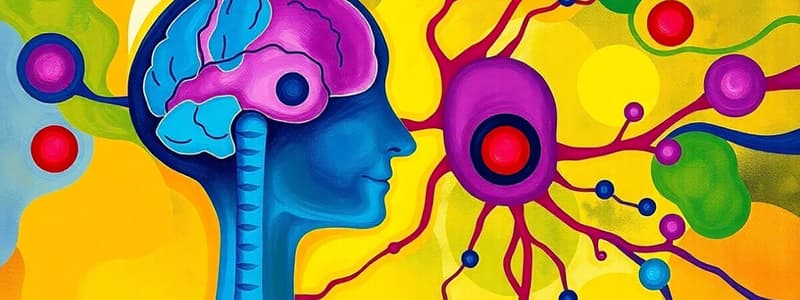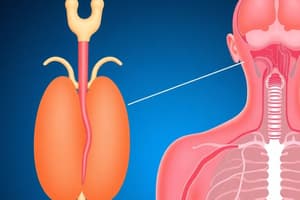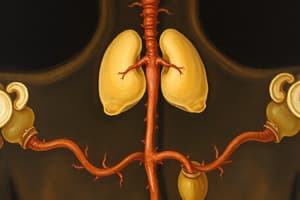Podcast
Questions and Answers
Which of the following statements about agonists is incorrect?
Which of the following statements about agonists is incorrect?
- Agonists trigger a cell response.
- Agonists compete with other messengers for the receptor site. (correct)
- Phenylephrine acts as an agonist for adrenaline.
- Agonists bind to a receptor.
What is the primary action of antagonists as described in the content?
What is the primary action of antagonists as described in the content?
- They enhance the effects of agonists.
- They bind to a receptor and trigger a cell response.
- They mimic the action of hormones.
- They prevent the natural hormone from binding by occupying the receptor site. (correct)
Which receptor is involved in the binding of acetylcholine at neuromuscular junctions?
Which receptor is involved in the binding of acetylcholine at neuromuscular junctions?
- Muscarinic receptors
- Androgen receptors
- Adrenaline receptors
- Nicotinic receptors (correct)
Which of the following uses an antagonist in medical treatments?
Which of the following uses an antagonist in medical treatments?
What effect can muscarine have on the body, given it mimics acetylcholine?
What effect can muscarine have on the body, given it mimics acetylcholine?
What is the primary function of hormones produced by endocrine glands?
What is the primary function of hormones produced by endocrine glands?
Which of the following describes the speed of response for the nervous system compared to the endocrine system?
Which of the following describes the speed of response for the nervous system compared to the endocrine system?
Which component of the neuro-endocrine communication mechanism is involved in producing hormones?
Which component of the neuro-endocrine communication mechanism is involved in producing hormones?
What is a chemical secreted in bodily fluids like sweat that influences behavior in the opposite sex of the same species?
What is a chemical secreted in bodily fluids like sweat that influences behavior in the opposite sex of the same species?
How are the nervous and endocrine systems similar in their function?
How are the nervous and endocrine systems similar in their function?
What role does free hormone play in the body?
What role does free hormone play in the body?
How does bound hormone affect the circulatory half-life of hormones?
How does bound hormone affect the circulatory half-life of hormones?
What is the main function of negative feedback loops in hormone regulation?
What is the main function of negative feedback loops in hormone regulation?
What characterizes synergism in hormone interactions?
What characterizes synergism in hormone interactions?
Which of the following is a characteristic of permissiveness in hormone interaction?
Which of the following is a characteristic of permissiveness in hormone interaction?
What type of stimuli leads to the release of parathyroid hormone (PTH)?
What type of stimuli leads to the release of parathyroid hormone (PTH)?
What is a key concept associated with the synthesis and secretion of hormones?
What is a key concept associated with the synthesis and secretion of hormones?
Which factor does NOT directly affect hormone concentration as perceivable by target cells?
Which factor does NOT directly affect hormone concentration as perceivable by target cells?
What defines the autocrine mechanism of signaling?
What defines the autocrine mechanism of signaling?
Which mechanism is primarily responsible for long-distance signaling?
Which mechanism is primarily responsible for long-distance signaling?
How are paracrine signals characterized in their function?
How are paracrine signals characterized in their function?
What role do prostaglandins play in cell signaling?
What role do prostaglandins play in cell signaling?
Which communication system integrates stimuli and responds to internal and external changes?
Which communication system integrates stimuli and responds to internal and external changes?
What differentiates the endocrine mechanism from other communication systems?
What differentiates the endocrine mechanism from other communication systems?
In what context are cytokines primarily involved?
In what context are cytokines primarily involved?
Which type of signaling is characterized by quick inactivation after release?
Which type of signaling is characterized by quick inactivation after release?
Flashcards
Hormone Action
Hormone Action
Hormones are chemical messengers produced by endocrine glands. They enter the bloodstream and travel to distant cells with specific receptors, triggering a response.
Neuro-endocrine Mechanism
Neuro-endocrine Mechanism
This refers to the communication system involving both the nervous system and the endocrine system. The nervous system senses a stimulus and triggers the release of hormones by specialized cells.
Pheromones
Pheromones
Chemicals released in bodily fluids, such as sweat, that influence the behavior of other individuals of the same species, especially regarding mating.
Nervous and Endocrine Communication: Similarities
Nervous and Endocrine Communication: Similarities
Signup and view all the flashcards
Nervous and Endocrine Communication: Differences
Nervous and Endocrine Communication: Differences
Signup and view all the flashcards
Cell-Cell Communication
Cell-Cell Communication
Signup and view all the flashcards
Long-Range Signaling
Long-Range Signaling
Signup and view all the flashcards
Specialized Cell Types
Specialized Cell Types
Signup and view all the flashcards
Major Communication Systems
Major Communication Systems
Signup and view all the flashcards
Neurotransmitters
Neurotransmitters
Signup and view all the flashcards
Cytokines
Cytokines
Signup and view all the flashcards
Autocrine Signaling
Autocrine Signaling
Signup and view all the flashcards
Free Hormone
Free Hormone
Signup and view all the flashcards
Bound Hormone
Bound Hormone
Signup and view all the flashcards
What is the role of protein in hormone secretion?
What is the role of protein in hormone secretion?
Signup and view all the flashcards
Negative Feedback
Negative Feedback
Signup and view all the flashcards
Positive Feedback
Positive Feedback
Signup and view all the flashcards
Humoral Stimuli
Humoral Stimuli
Signup and view all the flashcards
Neural Stimuli
Neural Stimuli
Signup and view all the flashcards
Hormone Interaction: Synergism
Hormone Interaction: Synergism
Signup and view all the flashcards
Agonist
Agonist
Signup and view all the flashcards
Antagonist
Antagonist
Signup and view all the flashcards
Phenylephrine
Phenylephrine
Signup and view all the flashcards
Muscarinic Receptor
Muscarinic Receptor
Signup and view all the flashcards
Nicotinic Receptor
Nicotinic Receptor
Signup and view all the flashcards
Study Notes
Hypothalamic Hormones and Pituitary Hormones
- The hypothalamus releases hormones that regulate the anterior pituitary
- These hormones (GnRH, CRH, TRH, PRH, Dopamine, GHRH, Somato-statin) act on the anterior pituitary
- The anterior pituitary then releases its own hormones (FSH/LH, ACTH, TSH, Prolactin, GH)
- These hormones regulate various target organs such as Gonads, Adrenal Cortex, Thyroid, Mammary Gland
- The posterior pituitary releases ADH and oxytocin
Cell-Cell Communication
- Complex multicellular organisms need long-range signaling
- Specialized cells have evolved for intercellular communication
- Key communication systems include Nervous System, Endocrine, and Immune Cells
Autocrine Mechanism of Signaling
- A signal released by a cell affects the same cell type
- Signals are quickly inactivated
- An example is prostaglandin
Prostaglandin Autocrine Control
- Autocrine control involves the signaling of a cell to itself via prostaglandins
- This signaling plays a role in growth and migration
Paracrine Mechanism of Communication
- Cells release signals that affect neighboring cells
- These signals act locally, without traveling in the bloodstream
Paracrine Regulation in the Pancreas
- Different cells in the pancreas (alpha, beta, delta) release hormones (glucagon, insulin, somatostatin) that affect neighboring cells in the pancreas
Endocrine Mechanism of Communication
- Hormones produced by endocrine glands travel through the bloodstream
- These hormones affect distant cells having specific receptors
Neuro-Endocrine Mechanism of Communication
- A nervous system stimulus triggers specialized neuro-endocrine cells to release hormones
- These hormones can initiate an appropriate response
Pheromones
- Chemicals secreted in sweat and other bodily fluids influencing the behavior of the opposite sex in the same species
Nervous and Endocrine Communication - Similarities
- Both share common messengers (e.g., epinephrine)
- Both are associated with the brain (hypothalamus)
- The systems are cooperative, with nerves secreting neurohormones, and some endocrine parts innervated directly by the nervous system
Nervous and Endocrine Communication - Differences
- Nervous system uses axons for unidirectional signaling, whereas the endocrine system uses the bloodstream
- Nerve impulses are fast (milliseconds), while hormonal responses are slower (seconds to days)
Amplitude vs. Frequency Modulation
- Hormone concentration is a slow (minutes to hours) amplitude modulation,
- Nerve impulses are rapid (milliseconds) frequency modulated
Controlling Hormone Secretion
- Hormone control depends on the rate of production, delivery, and degradation.
- Rates of synthesis and secretion are regulated (negative and positive feedback mechanisms)
Concentration of Hormone - As Seen By Target Cell
- Factors affecting hormone concentration in target cells include the rate of production, delivery and degradation/elimination.
Free Hormone
- Free hormone is the active form available for receptor binding.
- The fraction of free hormone is a critical factor in hormone response
- Clinical states of hormone excess/deficiency can be related to free hormone levels
Bound Hormone
- Bound hormones are inactive because they are combined with plasma proteins.
- Being inactive, they still significantly contribute to the circulatory pool of hormone
Synthesis and Secretion of Hormones
- Synthesis and secretion are the most important aspects of endocrine control
- Mechanisms include negative feedback and less commonly, positive feedback.
Negative Feedback Loops
- Hormones have feedback loops to regulate hormone levels
- A reduction in hormone (like in the thyroid section) causes the secretion of more hormone from the pituitary and hypothalamus to raise hormone levels
Positive Feedback Loops
- Feedback loops that enhance the production of hormones
- This is seen during child birth where levels of oxytocin are increased
Humoral Stimuli - Blood Chemistry
- Blood chemistry influences hormone secretion, with high and low levels of certain chemicals influencing the secretion of hormones to maintain a balance
Humoral Stimuli - Glucose Insulin
- Blood glucose levels influence the secretion of insulin
- Higher glucose levels cause higher insulin secretion
Neural Stimuli Control
- A neuron innervating an endocrine cell triggers stimulatory and inhibitory neurotransmitter secretion.
- This controls whether or not hormones are released
Control by Hormonal Stimuli
- The hypothalamus releases hormones to stimulate or inhibit anterior and posterior pituitary hormones
- The pituitary gland then releases hormones to target another endocrine gland leading to hormone production
Hormone Interaction
- Synergism occurs when two or more hormones produce similar effects
- Permissiveness implies one hormone needs another hormone for full effect,
- Examples include epinephrine, cortisol, and glucagon
Receptor Agonists and Antagonists
- Agonists—mimic the action of natural hormones/neurotransmitters
- Antagonists—block receptor binding, preventing natural hormone/neurotransmitter action
Agonists Mimic Normal Hormone Response
- Agonists bind to specific receptors to mimic a natural hormone response
- Phenylephrine– an example
- Used in specific medical treatments
Antagonists
- Antagonists bind to specific receptors
- They do not trigger a cellular response.
- Examples include androgen antagonist in prostate cancer treatment
Receptors
- Muscarinic Receptors
- Bind acetylcholine (ACh) from the autonomic nervous system
- Nicotinic Receptors
- Bind acetylcholine at neuromuscular junctions.
Studying That Suits You
Use AI to generate personalized quizzes and flashcards to suit your learning preferences.



